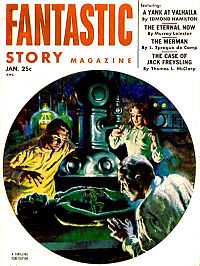Earle K. Bergey

Earle K. Bergey (August 26, 1901 – 1952) was an American artist and illustrator who painted cover art for thousands of pulp fiction magazines and paperback books. One of the most prolific pulp fiction artists of the 20th century, Bergey is recognized for creating the iconic cover of Gentlemen Prefer Blondes for Popular Library at the height of his career in 1948.
Born in Philadelphia, Pennsylvania, Bergey attended Pennsylvania Academy of Fine Arts from 1921 to 1926, finishing formal Academy studies in the spring of 1926. He initially went to work in the art departments of Philadelphia newspapers including Public Ledger, and he drew the comic strip Deb Days in 1927. Early in his career, Bergey contributed many covers to the pulp magazines of publisher Fiction House. By the mid-1930s, Bergey made a home and studio in Bucks County, Pennsylvania, and he married in 1935.
Pulp magazines
Throughout the 1930s, Bergey worked freelance for a number of publishing houses. His eye-catching paintings were predominately featured as covers on a wide array of pulp magazines, including romance (Thrilling Love, Popular Love, Love Romances) as well as detective, adventure, aviation, and Westerns. Bergey illustrated mainstream publications, such as The Saturday Evening Post, during this time. He illustrated covers for fitness magazines. Along with pin-up painting peers such as Enoch Bolles and H.J. Ward, Earle K. Bergey was one of first prominent American pin-up artists, contributing hundreds of covers to influential magazines including Gay Book Magazine, Pep Stories, and Snappy.
During the 1940s, Bergey continued to paint covers for romance, sports, and detective pulp magazines, and he began working on a number of science fiction magazines, including Standard Publications' Strange Stories, Startling Stories, and Captain Future, and later for Fantastic Story Magazine. His illustrations of scantily-clad women surviving in outer space served as an inspiration for Princess Leia's slave-girl outfit in Return of the Jedi and Madonna's conical brass brassiere. Bergey's science fiction covers, sometimes described as "Bim, BEM, Bum," usually featured a woman being menaced by a Bug-Eyed Monster, alien, or robot, with an heroic male astronaut coming to her assistance. Bikini-tops worn by Bergey girls often resembled coppery metal, giving rise to the phrase "the girl in the brass bra," sometimes used in reference to this sort of art.
Paperbacks
In 1948, Bergey made the transition to the rapidly expanding paperback book industry along with skilled pulp artists like Rudolph Belarski, whose work is often confused with Bergey's. While continuing to paint pulp covers until his death, Bergey sold illustrations to at least four (4) leading paperback publishing houses, including Popular Library and Pocket Books. His art graced the covers of dozens of novels and helped to sell millions of volumes. His paperback cover illustrations were as diverse as his work for the pulps. In addition to his work on Anita Loos' famous Gentlemen Prefer Blondes, Bergey painted cover art for well-known authors from Émile Zola to the Western master, Zane Grey, whose 1951 Pocket Books edition cover painting for Spirit Of The Border is a Bergey classic. Many of his paperbacks are now cult classics, some featuring hidden self-portraits. Bergey died suddenly and unexpectedly in 1952 with family at his side.
See also
- Good girl art
- List of pinup artists
- Paperback
- Pin-up girl
- Thrilling Publications
External links
- Earle Bergey at the Internet Speculative Fiction Database
- 14 covers by Bergey
- Earle K. Bergey artwork can be viewed at American Art Archives web site
- Official site for the artist Earle K. Bergey - coming soon
References
- Martignette, Charles G.; Louis K. Meisel (1996). The Great American Pin-up. Cologne: Taschen. ISBN 3-8228-1701-5.
- Strickler, Dave. Syndicated Comic Strips and Artists, 1924-1995: The Complete Index. Cambria, CA: Comics Access, 1995. ISBN 0-9700077-0-1.